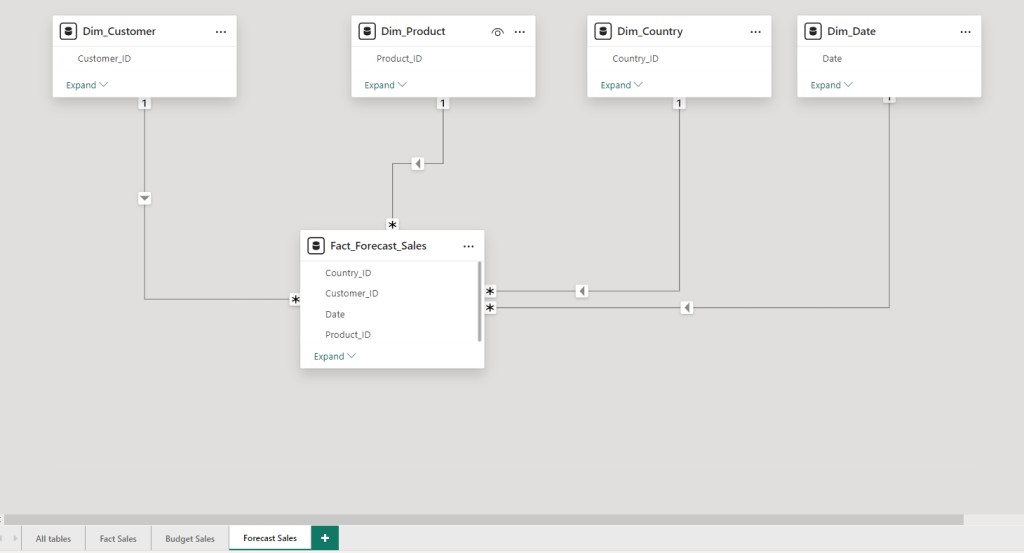In today’s dynamic business environment, understanding your financial performance is paramount. A crucial aspect of this understanding lies in effectively comparing actual results to budgeted results. This analysis provides invaluable insights, highlighting areas of success and pinpointing areas needing improvement. For content creators and business professionals leveraging data visualization tools like Power BI, mastering this comparison is a game-changer. This guide will delve into how to seamlessly conduct a budget vs. actual analysis in Power BI, empowering you to make informed, data-driven decisions.
Why Budget vs. Actual Comparison is Essential
Comparing actual results to budgeted results is not just a routine task; it’s a strategic imperative. Here’s why this analysis is so critical for businesses of all sizes:
- Trend Identification: By juxtaposing budgeted figures against real-time performance, you can swiftly identify emerging trends. Are sales consistently exceeding projections in one region but lagging in another? Budget vs. actual analysis provides the clarity to spot these patterns early, enabling proactive responses.
- Strategic Planning Enhancement: The insights gleaned from these comparisons are instrumental in refining future budgets and strategic plans. Understanding past variances – both positive and negative – allows for more realistic and data-backed forecasting and resource allocation.
- Resource Optimization: Knowing where your business is overperforming and underperforming is key to efficient resource allocation. Are marketing efforts yielding higher returns in specific product lines compared to budget? This analysis helps you channel resources to areas with the greatest impact.
- Actionable Management Insights: Presenting a clear, numbers-driven comparison of budget vs. actual performance equips management with the information they need to understand variances and take decisive action. Whether explaining deviations to the CFO or a wider audience, this analysis provides concrete evidence and facilitates informed discussions.
Having actual and budget data consolidated in a unified platform like Power BI is a significant advantage. It streamlines analysis, saves time, and eliminates the inefficiencies of manual data manipulation. Many professionals have experienced the frustration of juggling spreadsheets and manual data merging. This guide offers a streamlined, efficient approach to performing these critical comparisons directly within Power BI.
Building a Robust Data Model for Effective Comparison
The foundation of any insightful budget vs. actual analysis in Power BI is a well-structured data model. This model ensures data integrity and facilitates seamless comparisons. Here’s how to set up your data model effectively:
-
Data Segregation: Begin by organizing your data into distinct tables. Crucially, separate your actual results data from your budget or forecast data. This separation is fundamental for clear and accurate comparisons. Additionally, establish separate dimension tables. These tables will define the key attributes of your data, such as time, product, and region.
-
Dimension Table Creation: Dimension tables are central to creating a relational data model. Essential dimensions include:
- Date Table: This table provides a comprehensive timeline, enabling analysis across different time periods.
- Customer Table: Details about your customer base, allowing for customer-centric performance analysis.
- Product Table: Information on your product offerings, facilitating product-level budget vs. actual comparisons.
- Region/Country Table: Geographic data, enabling regional performance analysis.
-
Establishing Relationships (Crucial Step): The power of your data model lies in the relationships between tables. Implement 1-to-many relationships connecting your dimension tables to your fact tables (actuals and budget). This relational structure allows Power BI to intelligently link and analyze data across dimensions. Ensure that key identifiers like Customer ID, Product ID, Country ID, and Date are consistently present in both dimension and fact tables to enable these relationships.
- Consistent Column Structure: Maintaining a uniform column structure across your actual, budget, and forecast fact tables is paramount for comparability. If your actual sales table includes a customer column, your budget table must also have a corresponding column, even if budget data isn’t available at that granular level. Without consistent columns, direct comparisons become impossible. In the example model, all fact tables share columns for date, product_id, customer_id, and country_id, ensuring seamless comparison capabilities.
Pro Tip: Utilize Power BI’s relationship view and the “collapse text” feature to simplify the visualization of your data model. Collapsing text will highlight only the columns involved in relationships, making it easier to verify the connections between fact and dimension tables.
If you’re looking to practice data model creation, consider leveraging tools like ChatGPT (versions 4 or 4o are recommended for enhanced data generation capabilities) to create a sample portfolio dataset. Resources are available that provide step-by-step instructions and prompts for generating Excel files containing fact and dimension tables suitable for this type of Power BI project. Furthermore, complete Power BI Desktop files are often shared to provide hands-on learning resources.
Handling Monthly Budget Data Granularity
Budget and forecast data frequently arrive at a monthly level of detail rather than daily. You might encounter Excel files named “Budget March 2022” or sheets within files representing individual months. The critical step is to create a date field column within your budget/forecast data. A date-type column is essential for establishing a connection with your date dimension table.
In simplified scenarios, a date field might be readily available, perhaps representing the first day of each month (e.g., January 1st, February 1st). This approach allows for monthly aggregation and linkage to the date table. However, it’s important to recognize the limitation: with monthly budget data, direct comparisons against daily sales are not feasible without employing more advanced custom measures, which are a topic for more specialized discussions.
Visualizing Budget vs. Actual with Zebra BI Visuals in Power BI
Once your data model is robustly structured, the next step is to bring your budget vs. actual comparison to life through visualization in Power BI. Zebra BI visuals are powerful tools renowned for creating actionable business intelligence dashboards that adhere to the International Business Communication Standards (IBCS). While Zebra BI is a commercial solution with an annual license fee, primarily suited for enterprise users, a 30-day free trial is available for evaluation. Learn more about Zebra BI and explore its capabilities. For Power BI developers focused on creating impactful and easily interpretable reports, Zebra BI visuals can significantly streamline the process.
-
Importing Zebra BI Visuals:
- Access the “Get more visuals” marketplace within Power BI Desktop.
- Search for “Zebra BI” and download their Table, Charts, and KPI Card visuals.
- Zebra BI visuals are designed for efficiency, often requiring only two measures to generate insightful visualizations. They excel at highlighting performance variances through intuitive color-coding, making it immediately clear which periods or categories are performing well or poorly. The benefits of Zebra BI extend beyond this, with further advantages explored in dedicated resources.
-
License Activation or Trial Initiation:
- As a paid tool, Zebra BI requires a license key or activation of the 30-day free trial to unlock full functionality. Without a license, the visuals will have limited features.
-
Time-Series Visualization:
- Utilize the Zebra BI Chart visual to display trends over time, a crucial aspect of budget vs. actual analysis.
- Drag your Month or Year column from your Date dimension table to the “Category” field of the visual.
- Populate the “Values” field with your actuals measure (e.g., sum of gross sales) and the “Plan” field with your budgeted measure (e.g., sum of budgeted sales). These measures typically involve simple aggregation functions like “sum” applied to your respective sales columns from the actual and budget tables.
- Interactive Exploration and Insight Extraction:
- Leverage Power BI’s interactive capabilities to drill down into the visualized data and uncover deeper insights. Focus your initial analysis on the most prominent variances, indicated by red (under budget) and green (over budget) areas. For example, if October shows a 2.3% shortfall against budget, representing a €6,000 deviation, investigate further. Explore different categories and dimensions to pinpoint the underlying drivers of this negative variance in October.
By following these steps, you can create dynamic dashboards that effectively visualize the comparison of actual results against your budget, empowering data-driven decision-making. You can readily identify periods of over or underperformance and then drill into specific categories to understand the root causes.
Extending the analysis to product categories is straightforward.
- Select the Zebra BI Table visual.
- Drag your product category column from your Product dimension table to the “Category” field. Ensure that your product dimension table is related to both your actuals and budget fact tables.
- Add your actual sales measure (sum of sales from actuals) to the “Values” field.
- Add your budgeted sales measure (sum of sales from budget data) to the “Plan” field. The “Plan” field in Zebra BI visuals is designed to represent budget or target values.
Still Unclear? Access a Ready-Made Solution
For those seeking a hands-on example, a pre-built Power BI report is available for download. This report includes a complete data model, pre-configured measures, and Zebra BI visual settings, providing a practical starting point for your own budget vs. actual analysis projects.
Conclusion: Unlocking Data-Driven Insights through Budget vs. Actual Analysis
Comparing actual results to budgeted results in Power BI is a powerful technique for maintaining a close watch on your business performance. By establishing a well-designed data model and leveraging the visualization capabilities of tools like Zebra BI, you can transform raw data into actionable insights with relative ease. This analysis empowers you to move beyond simply reporting numbers to truly understanding the drivers of performance and making informed strategic decisions.
Stay Informed
This guide is just the beginning of exploring dynamic Power BI reporting techniques. Stay tuned for upcoming articles in this series, which will cover a range of topics designed to help you maximize the value of your data. Future topics will include techniques for dynamically switching between different KPIs across visuals, such as gross sales, discounts, and net sales, without relying on complex button or bookmark setups.

